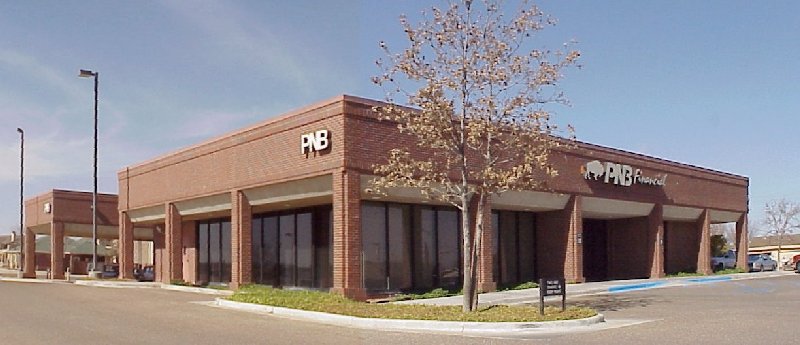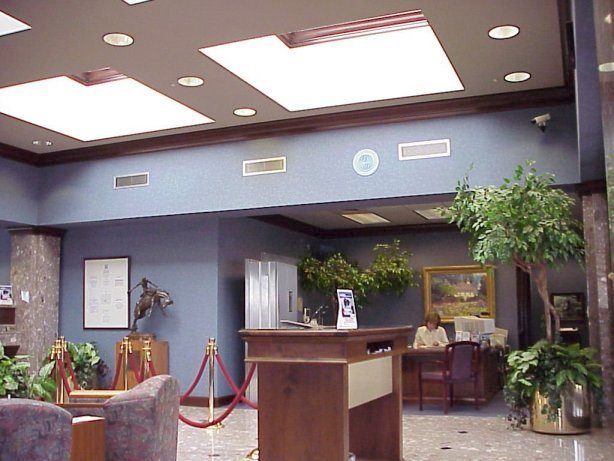The Style of Stiles and Stiles
 Edward Stiles is the antithesis
of the oxymoron. Some find humor in a figure of speech which combines contradictory
terms. Ask anyone for an oxymoron and the one you more than likely get
is "Military Intelligence." Ed, who served his country as an
intelligence officer in Vietnam, lets you have your little joke, but the
wrinkles in the corner of his eyes tell you he doesnít think it is very
funny. Some would snicker at the term "Student Athlete," but
the jock that earned a degree in architecture on an athletic scholarship
playing third base for the legendary Burl Huffman just smiles. The oxymoron
that Stiles really legitimizes is "Modest Architect."
Edward Stiles is the antithesis
of the oxymoron. Some find humor in a figure of speech which combines contradictory
terms. Ask anyone for an oxymoron and the one you more than likely get
is "Military Intelligence." Ed, who served his country as an
intelligence officer in Vietnam, lets you have your little joke, but the
wrinkles in the corner of his eyes tell you he doesnít think it is very
funny. Some would snicker at the term "Student Athlete," but
the jock that earned a degree in architecture on an athletic scholarship
playing third base for the legendary Burl Huffman just smiles. The oxymoron
that Stiles really legitimizes is "Modest Architect."
Practicing a profession where modesty is not a common virtue, Stiles
quietly goes about decorating our city with his timeless designs. "Where,"
you might ask, "is the modesty in that?" The answer lies in the
projects for which Ed takes little credit for himself, but gives others
most of the credit for the design. Several significant examples come to
mind.
1) LakeRidge United Methodist Church. The schematic design was the brainchild
of others. Stiles did the construction working drawings or "blueprints"
if you prefer.
2) Lubbock Commercial Buildings, Inc. on 82nd street. The Rushings knew
what they wanted and Stiles delivered. Dub Rushing, legendary icon of Lubbock,
has left his mark on many a development in this town.
3) The old Hemphill Wells Building downtown. Originally this was the
flagship department store of Lubbock designed by Haynes and Kirby in 1948.
Stiles has orchestrated a master plan and implemented phase I which moved
the Operations Department of Plains National Bank into the second floor.
4) Lubbock Housing Authority projects were remodeled by Stiles during
the glory days of LHA under the direction of the legendary administrator
D. C. Fair. (D. C. sponsored Ed for membership in the Lubbock Rotary Club,
a signal honor)
There are other examples; you get the idea. "But," you might
ask, "what happens when you give Ed a free hand to design your building
his way?" Something quite remarkable!
But first, a brief look at the history and organization that is Stiles
and Stiles. This firm, along with MWM, RTR, and a couple of others are
the successors to the firm of SRMJ (Stiles, Roberts, Messersmith, and Johnson).
Marvin Stiles, the father, and Edward Stiles, the son, continued in practice
in the same office on 34th Street from 1977 and never skipped a beat.
Stiles, the elder, was one of Lubbockís legendary talents. He was a
man of monumental ability with the physical attributes to go with it. It
was my great honor to work with Marvin Stiles as his mechanical consultant
for many years. One of the things I remember most about him was a wit that
matched West Texas weather - that is to say, very dry. Driving on an inspection
trip to Morton one day he and I were playing "Ainít it Awful"
on the subject of losing weight. Marvin popped a classic one liner, "The
least I ever weighed was the day I was born - Iíve weighed a little more
every day since." Marvin has been gone a few years now, but his name
is still on the door. Somehow that seems so appropriate. The office has
changed hardly at all. Sometimes when I am there, I am startled by the
feeling the big man is looking over my shoulder.
.

Enough nostalgia though, I want to talk about Stiles and Stiles today.
The organization is a model of efficiency: Edward Stiles (principal architect
and contract documents), Craig Wallace (project manager, graphics and partner
designate) and Edís niece, Mandy Stiles (reception and word processing).
A group just canít get any tighter than that. Yet by focusing on one job
at a time during the working drawings phase, their output is extraordinary.
The heir to the Stiles architectural dynasty and a kid from Cohoma with
a hot rod Camaro seems like an unlikely combination. I asked Ed, "How
did you and Craig get together in the first place?"
"Answer to a prayer", was the quick response. "In 1990
my time was so committed that I had to turn back some school projects for
the LISD that I really wanted to do. I was pretty depressed about it, and
the next day Craig came in and applied for an internship. He was a sophomore
architecture student at Texas Tech." Craig added, "That was ten
years and nearly 200 jobs ago. I believe I have been in on every one of
them. It does not seem that long since I did a day care center as my senior
project." Pretty practical thesis, I thought! "Well, yes,"
Ed quipped, "compared to a lunar colony!"
* * *
What is beauty in architecture? With the fervor of a prophet elaborating
on a virtuous woman, Edís vision is stated rather simply: "Beauty
has to come from the inside out. When the design flows from function, the
form it assumes is beautiful." When you look at an uninhibited Stiles
design, what you see is the Form Follows Function school of thought on
steroids.
Then it hits you: heís right, and he pulls it off with such style that
you see the personality of the building without the artificial ornamentation
that dates period architecture. Spaces just seem to morph into the most
logical geometry and relationship with each other and their environment
under the masterís deft touch.

New TxDOT Building in Lubbock
Neither Ed nor Craig has much use for façade architecture. Neither
has a taste for "gingerbread". They avoid the architecture of
the popular, eschewing cuteness for more enduring form.
Does that mean Stiles designs are sterile or austere? Hardly! When the
function requires elegance, as in for example a bank, Stiles is a master
at projecting image. It just has to be honest.
An example of the Stiles touch of elegance is the Plains Financial Building
on Slide Road in Lubbock. The exterior of the building is characterized
by rows of square columns supporting an encircling veranda with a contrasting
stucco ceiling. The drive-in bank picks up the lines of the building for
a totally integrated design. Discrete landscaping does not detract from
the building's geometric precision. Bank customers exit their vehicles
just a couple of steps from the shelter of the functional veranda. Convenient
indeed!

Plains Financial Building on Slide Road
Stepping through the glass doors of the vestibule brings you into a
skylighted reception area. The golden buffalo and PNB logo against the
dusky blue background draws your eye down to the marble customer service
counter. As your eye sweeps right past the substantial marble columns,
you spy the spectacular Grant Speed bronze, the solo art that is worthy
of display in this elegant setting. Then the massive stainless steel vault
door that speaks volumes about security, and friendly smile of the little
lady with the big computer.
Elegance worthy of a financial institution? I would say so.



All I's dotted and all T's crossed characterizes the documents issued
by Stiles' office. Drawings and specifications are "shipshape Bristol
fashion". They are literally signed, sealed, and delivered to the
bidders. And so is the final construction before he signs off on the final
payment to the contractor. It takes judgement and experience to make the
call in the field as to whether or not a material has been applied properly,
or whether or not craftsmanship is up to the standard of the trade. Ed
and Craig make those calls. "Yes, that is acceptable," you may
hear them say, or another time, "I am not buying that, take it out
and do it right." It is incredible that some projects get built without
that kind of expertise.
* * *
Ed mentioned a few other practical points: "There is a difference
between a good artist and a good professional. Sometimes a good artist
may draw something that nobody can afford to build. The good professional
never does. We don't covet flowery compliments, we prefer the substance
of repeat commissions."
"We try to take the long view on owning and operating costs. A
good building may last more than fifty years. We have clients who expect
to spend their career in the space we design for them. We take their costs,
comfort and convenience seriously."
.

Speaking of comfort, if you really want to know whether or not an architect
understands the scale of the human form, check out the toilets he designs.
Thatís where the primordial human emotions of privacy, territoriality,
and fears of vulnerability manifest themselves. I do not usually carry
my camera into the men's room because it makes people nervous. Besides,
the spaces are small and hard to photograph. I took one picture of what
I consider to be a perfect toilet that Stile designed. Enjoy the neatness.
.
.
Perfect Toilet
Stiles practices what I call "non-invasive" design. By that
I mean that when a building is inserted into an existing campus, Ed does
not try to make the other buildings look bad in comparison. Sometimes that's
hard to do, especially if the existing buildings are ugly or worse, period
dated.

An integrator, rather than a separator, Ed uses compatible materials,
color, distance and scale to achieve this effect. The new building on the
TxDOT campus in Amarillo illustrates the principle. The building in the
background is obviously thirty years old, but it still looks pretty good
up against the new Stiles design.
New TxDOT Building in Amarillo
For his conclusion Ed returns to lessons learned a long time ago, "Our
philosophy of practice is the Lou Holtz approach. First, we try do what's
right. Not whether it is legal or illegal, not whether it is ethical or
unethical: I am talking about right and wrong. Second, on every project
we strive to put forth our best effort, regardless of the size of the job.
Third, we believe in the Golden Rule. If those simple rules are followed,
they take care of a lot of problems. They may not make the building prettier,
but I sleep better at night."
Author's notes:

I dedicate these articles to the unsung design community
that makes Lubbock, Texas, my hometown, the Florence of the Southwest.
Recognition of their contribution to the beauty of our community is long
overdue. These interviews will be liberally edited and paraphrased in the
interest of brevity and levity. Yes, this is my college picture, circa
1956.
Barto Fanning
 Edward Stiles is the antithesis
of the oxymoron. Some find humor in a figure of speech which combines contradictory
terms. Ask anyone for an oxymoron and the one you more than likely get
is "Military Intelligence." Ed, who served his country as an
intelligence officer in Vietnam, lets you have your little joke, but the
wrinkles in the corner of his eyes tell you he doesnít think it is very
funny. Some would snicker at the term "Student Athlete," but
the jock that earned a degree in architecture on an athletic scholarship
playing third base for the legendary Burl Huffman just smiles. The oxymoron
that Stiles really legitimizes is "Modest Architect."
Edward Stiles is the antithesis
of the oxymoron. Some find humor in a figure of speech which combines contradictory
terms. Ask anyone for an oxymoron and the one you more than likely get
is "Military Intelligence." Ed, who served his country as an
intelligence officer in Vietnam, lets you have your little joke, but the
wrinkles in the corner of his eyes tell you he doesnít think it is very
funny. Some would snicker at the term "Student Athlete," but
the jock that earned a degree in architecture on an athletic scholarship
playing third base for the legendary Burl Huffman just smiles. The oxymoron
that Stiles really legitimizes is "Modest Architect."






